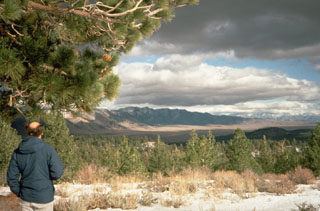Report on Long Valley (United States) — June 1996
Bulletin of the Global Volcanism Network, vol. 21, no. 6 (June 1996)
Managing Editor: Richard Wunderman.
Long Valley (United States) Two S-moat earthquake swarms during June
Please cite this report as:
Global Volcanism Program, 1996. Report on Long Valley (United States) (Wunderman, R., ed.). Bulletin of the Global Volcanism Network, 21:6. Smithsonian Institution. https://doi.org/10.5479/si.GVP.BGVN199606-323822
Long Valley
United States
37.7°N, 118.87°W; summit elev. 3390 m
All times are local (unless otherwise noted)
Moderate earthquake swarms on 14 and 19-21 June triggered a "D" alert status (moderate unrest) for the caldera. The D-status for the second swarm expired at 0600 on 28 June. The activity associated with these swarms is common in the caldera and poses little or no threat. Focal depths of both swarms centered around 5-6 km, and there was no significant ground deformation.
The first swarm, which began on the morning of 14 June, was centered at the SW margin of the resurgent dome (near the Highway 203/395 junction 5 km E of Mammoth Lakes). It included 17 M > 2 earthquakes and more than 150 events large enough to be located (M >0.5). The two largest events in this swarm were M 3.0 and 3.3 earthquakes at 0943 and 2154, respectively. This swarm gradually died out early the next morning.
The second swarm, centered 5 km to the E along the SE margin of the resurgent dome, began late in the evening of 18 June and gradually tailed off through the early morning of 21 June. This swarm included a M 3.3 earthquake at 0513 on 19 June, and over 33 events of M >2. The number of M >0.5 events detected and located through the morning of 21 June exceeded 400. This swarm was centered 2-3 km N of the 29 March-10 April S-moat swarm, which included three M > 4 earthquakes (BGVN 21:04).
This 17 x 32 km caldera formed about 730,000 years ago as a result of the Bishop Tuff eruption. Resurgent doming was followed by eruptions until ~50,000 years ago. Since then the caldera has remained thermally active, and in recent years, has undergone significant deformation. Although distinct from Long Valley Caldera, both Inyo Craters and Mammoth Mountain sit adjacent to it.
Geological Summary. The large 17 x 32 km Long Valley caldera east of the central Sierra Nevada Range formed as a result of the voluminous Bishop Tuff eruption about 760,000 years ago. Resurgent doming in the central part of the caldera occurred shortly afterwards, followed by rhyolitic eruptions from the caldera moat and the eruption of rhyodacite from outer ring fracture vents, ending about 50,000 years ago. During early resurgent doming the caldera was filled with a large lake that left strandlines on the caldera walls and the resurgent dome island; the lake eventually drained through the Owens River Gorge. The caldera remains thermally active, with many hot springs and fumaroles, and has had significant deformation, seismicity, and other unrest in recent years. The late-Pleistocene to Holocene Inyo Craters cut the NW topographic rim of the caldera, and along with Mammoth Mountain on the SW topographic rim, are west of the structural caldera and are chemically and tectonically distinct from the Long Valley magmatic system.
Information Contacts: David Hill, U.S. Geological Survey, MS 977, 345 Middlefield Rd., Menlo Park, CA 94025 USA (URL: https://volcanoes.usgs.gov/observatories/calvo/).

